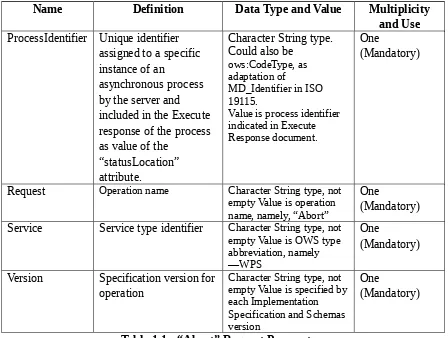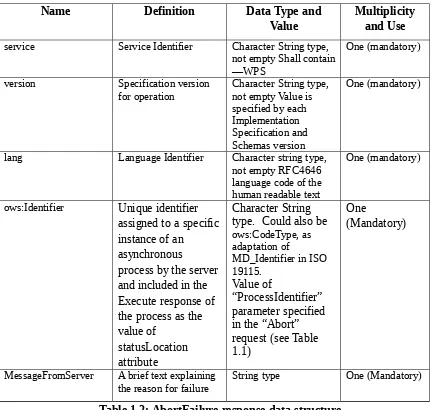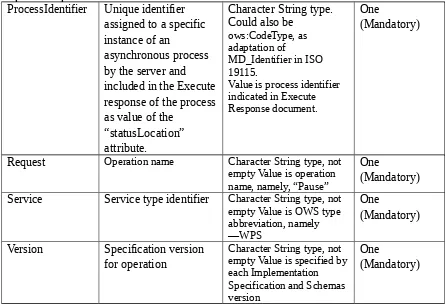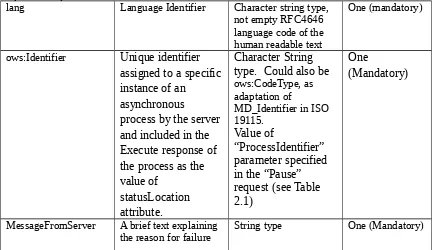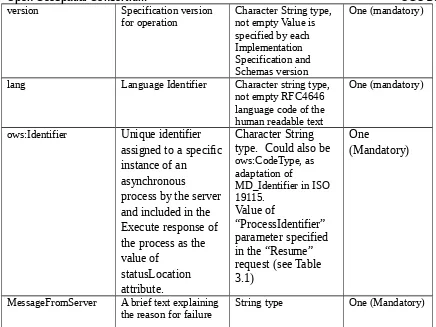CR-Form-v3
CHANGE REQUEST
WPS 1.0.0 CR ?
rev-2-
Current version: 1.0.0 For HELP on using this form, see bottom of this page or look at the pop-up text over the symbols.
Proposed change affects: AS Imp Spec X Best Practices Paper Other Title: Web Processing Service Change Request – methods for controlling asynchronous
process
Source: Science and Technology Facilities Council (STFC)
Work item code: Date: 23 June 2009
Category: B
Use one of the following categories:
F (Critical correction)
A (corresponds to a correction in an earlier release)
B (Addition of feature),
C (Functional modification of feature)
D (Editorial modification)
Detailed explanations of the above categories can be found in the TC Policies and Procedures.
Reason for change: Integrating OGC services with Grid technology is increasingly being seen as beneficial within the OGC community. The latest OGC test bed OWS-6 has run a thread of work that focused on integrating WPS with Grid computing to enable effective handling of resource-intensive geo-processes through standardised WPS. This work identified that the current version of WPS specification does not provide any mechanism for controlling an asynchronous process, which is a standard function of a Grid infrastructure and is often useful for managing the resources used by long running processes. We therefore envision that the users of a Grid-enabled WPS should have this option in order to be able to utilise the full benefit of Grid technology through standardised WPS.
Summary of change: Methods for controlling asynchronous process
Consequences if
not approved: Limits the benefits of Grid technology utilised through standardised WPS
Clauses affected:
Other specs Other core specifications Affected: Abstract specifications
Best Practices Document Supporting Doc.
Change 1: “Abort” Operation
1.1 Definition
Abort operation enables terminating an incomplete WPS asynchronous process, i.e. either awaiting execution (indicated by ProcessAccepted status in the WPS Execute response) or being executed (indicated by ProcessStarted status in WPS Execute
response). In terms of implementation, this operation should be optional and should only be applicable to the asynchronous processes that support this operation (i.e. as reflected in the DescribeProcess response of the process). Once successfully terminated, all
computational resources (e.g. CPU Power, RAM etc.) allocated to the process should be released. All process outputs (if applicable) should be deleted and it should not be possible to restart the process.
1.2 Abort Request Parameters
We propose that a request to terminate a process should include the parameters listed and defined in Table 1 below:
Name Definition Data Type and Value Multiplicity and Use
ProcessIdentifier Unique identifier assigned to a specific instance of an
asynchronous process by the server and included in the Execute response of the process as value of the
“statusLocation” attribute.
Character String type. Could also be
ows:CodeType, as adaptation of
MD_Identifier in ISO 19115.
Value is process identifier indicated in Execute Response document.
One
(Mandatory)
Request Operation name Character String type, not empty Value is operation name, namely, “Abort”
One
(Mandatory)
Service Service type identifier Character String type, not empty Value is OWS type abbreviation, namely ―WPS
One
(Mandatory)
Version Specification version for operation
Character String type, not empty Value is specified by each Implementation Specification and Schemas version
One
(Mandatory)
Table 1.1: “Abort” Request Parameters
Example GET “Abort” Process request:
http://foo.bar.1/wps?version=1.0.0&request=Abort&service=WPS&ProcessIdentifier=
cb1557397169547d63c2d1388e8dd810
Listing 1.1: Example GET “Abort” Process request
Example POST “Abort” Process Request:
<?xml version="1.0" encoding="UTF-8"?>
<wps:Abort xmlns:wps="http://www.opengis.net/wps/1.0.0" xmlns:ows="http://www.opengis.net/ows/1.1"
xmlns:xlink="http://www.w3.org/1999/xlink"
xmlns:xsi="http://www.w3.org/2001/XMLSchema-instance"
xsi:schemaLocation="http://www.opengis.net/wps/1.0.0 ../wpsAbort_request.xsd" service="WPS" version="1.0.0" language="en-CA">
<ows:Identifier>cb1557397169547d63c2d1388e8dd810</ows:Identifier> </wps:Abort>
Listing 1.2: Example POST “Abort” Process Request
1.4 “Abort” Operation Response
The response to a successful Abort operation should be a revised version of WPS Execute response document with the “wps:Status” element containing the child element
“wps:ProcessTerminated” indicating that the process has been terminated.
Example WPS response:
<?xml version="1.0" encoding="UTF-8"?>
<wps:ExecuteResponse
xmlns:wps=http://www.opengis.net/wps/1.0.0...statusLocation="cb1557397169547d63c 2d1388e8dd810" xsi:schemaLocation="http://www.opengis.net/wps/1.0.0
http://schemas.opengis.net/wps/1.0.0/wpsExecute_response.xsd"> <wps:Process wps:processVersion="1.0">
<ows:Identifier>RunTraj</ows:Identifier>
<ows:Title>BADC Trajectory Service</ows:Title> </wps:Process>
<wps:Status creationTime="2009-05-29T13:00:03.0Z">
<wps:ProcessTerminated terminationTime="2009-05-29T14:00:03.0Z"/> </wps:Status>
<wps:ProcessOutputs>...</wps:ProcessOutputs> </wps:ExecuteResponse>
Listing 1.3: An example WPS response to “Abort” request
The WPS server should notify a failure in terminating a process following a “Abort” request by sending an appropriate XML-based “Failure” response. We propose the following structure of a failure response to a “Abort” request:
2. The document should contain a server specific identifier of the process in question an appropriate text indicating the reason for failure
3. The response should have the following data structure:
Name Definition Data Type and Value
Multiplicity and Use service Service Identifier Character String type,
not empty Shall contain ―WPS
One (mandatory)
version Specification version
for operation Character String type, not empty Value is specified by each Implementation Specification and Schemas version
One (mandatory)
lang Language Identifier Character string type, not empty RFC4646 language code of the human readable text
One (mandatory)
ows:Identifier Unique identifier assigned to a specific instance of an asynchronous process by the server and included in the Execute response of the process as the value of
statusLocation attribute
Character String type. Could also be
ows:CodeType, as adaptation of
MD_Identifier in ISO 19115.
Value of
“ProcessIdentifier” parameter specified in the “Abort” request (see Table 1.1)
One
(Mandatory)
MessageFromServer A brief text explaining
the reason for failure String type One (Mandatory)
Table 1.2: AbortFailure response data structure
Example failure response for Abort operation:
<?xml version="1.0" encoding="UTF-8"?>
<AbortFailure xmlns="http://www.opengis.net/wps/1.0.0" xmlns:ows="http://www.opengis.net/ows/1.1"
xmlns:xlink="http://www.w3.org/1999/xlink"
xmlns:xsi="http://www.w3.org/2001/XMLSchema-instance"
xsi:schemaLocation="http://www.opengis.net/wps/1.0.0 ../wpsxxxxxt.xsd" service="WPS" version="1.0.0" language="en-CA">
<ows:Identifier>cb1557397169547d63c2d1388e8dd810</ows:Identifier> <MessageFromServer>Unable to cancel process as it has already
Listing 1.4
Attempts to control a process that doesn’t support “Abort” operation should throw a relevant OWS Exception as below:
<?xml version="1.0" encoding="UTF-8"?>
<ExceptionReport xmlns="http://www.opengis.net/ows/1.1" xmlns:xsi="http://www.w3.org/2001/XMLSchema-instance"
xsi:schemaLocation="http://www.opengis.net/ows/1.1 ../owsExceptionReport.xsd" version="1.0.0" xml:lang="en">
<Exception exceptionCode="InvalidOperation">
<ExceptionText>”Abort” is not a valid operation for this process</ExceptionText>
</Exception> </ExceptionReport>
Listing 1.5
Change 2: “Pause” Operation
2.1 Definition
Pause operation enables suspending an incomplete WPS asynchronous process, i.e. either awaiting execution (indicated by ProcessAccepted status in the WPS Execute response) or being executed (indicated by ProcessStarted status in WPS Execute response). In terms of implementation, this operation should be optional and should only be applicable to the asynchronous processes that support this operation (i.e. as reflected in the
DescribeProcess response of the process). Once successfully paused, all computational resources (e.g. CPU Power, RAM etc.) allocated to the process should be released. However, all process related resources, such as data inputs, configuration information, and outputs (if applicable) should be stored to enable resumption of the process at a later stage. A paused process must be resumed within a time period, specified by the server otherwise one of the following actions may be taken:
The process is terminated and all process outputs (if applicable) are deleted
The process is resumed as normal.
2.2 Pause Request Parameters
We propose that a request to pause a process should include the parameters listed and defined in Table 2.1 below:
ProcessIdentifier Unique identifier assigned to a specific instance of an
asynchronous process by the server and included in the Execute response of the process as value of the
“statusLocation” attribute.
Character String type. Could also be
ows:CodeType, as adaptation of
MD_Identifier in ISO 19115.
Value is process identifier indicated in Execute Response document.
One
(Mandatory)
Request Operation name Character String type, not empty Value is operation name, namely, “Pause”
One
(Mandatory) Service Service type identifier Character String type, not
empty Value is OWS type abbreviation, namely ―WPS
One
(Mandatory)
Version Specification version for operation
Character String type, not empty Value is specified by each Implementation Specification and Schemas version
One
(Mandatory)
Table 2.1: “Pause” Request Parameters
2.3 Example “Pause” Requests
Example GET “Pause” Process request:
http://foo.bar.1/wps?version=1.0.0&request=Pause&service=WPS&ProcessIdentifier=
cb1557397169547d63c2d1388e8dd810
Listing 2.1: Example GET “Pause” Process request
Example POST “Pause” Process Request:
<?xml version="1.0" encoding="UTF-8"?>
<wps:Pause xmlns:wps="http://www.opengis.net/wps/1.0.0" xmlns:ows="http://www.opengis.net/ows/1.1"
xmlns:xlink="http://www.w3.org/1999/xlink"
xmlns:xsi="http://www.w3.org/2001/XMLSchema-instance"
xsi:schemaLocation="http://www.opengis.net/wps/1.0.0 ../wpsPause_request.xsd" service="WPS" version="1.0.0" language="en-CA">
<ows:Identifier>cb1557397169547d63c2d1388e8dd810</ows:Identifier> </wps:Pause>
Listing 2.2: Example POST “Pause” Process Request
The response to a successful Pause operation should be a standard version of WPS Execute response document with the “wps:Status” element containing the child element “wps:ProcessPaused” (already exists in the wps Execute response schema) indicating that the process has been suspended. The “wps:status” should also contain the maximum time (e.g. using an appropriate attribute “maxPausedTime” – Listing 2.3) within which the process must be restarted.
Example WPS response:
<?xml version="1.0" encoding="UTF-8"?>
<wps:ExecuteResponse
xmlns:wps=http://www.opengis.net/wps/1.0.0...statusLocation="cb1557397169547d63c 2d1388e8dd810" xsi:schemaLocation="http://www.opengis.net/wps/1.0.0
http://schemas.opengis.net/wps/1.0.0/wpsExecute_response.xsd"> <wps:Process wps:processVersion="1.0">
<ows:Identifier>RunTraj</ows:Identifier>
<ows:Title>BADC Trajectory Service</ows:Title> </wps:Process>
<wps:Status creationTime="2009-05-29T13:00:03.0Z">
<wps:ProcessPaused pauseTime="2009-05-29T14:00:03.0Z" maxPausedTime=”2009-05-29T14:00:018.0Z”/>
</wps:Status>
<wps:ProcessOutputs>...</wps:ProcessOutputs> </wps:ExecuteResponse>
Listing 2.3: An example WPS response to “Pause” request
The WPS server should notify a failure in suspending a process following a “Pause” request by sending an appropriate XML-based “Failure” response. We propose the following structure of a failure response to a “Pause” request:
1. The response should be a “PauseFailure” XML document
2. The document should contain a server specific identifier of the process in question an appropriate text indicating the reason for failure
3. The response should have the following data structure:
Name Definition Data Type and Value
Multiplicity and Use service Service Identifier Character String type,
not empty Shall contain ―WPS
One (mandatory)
version Specification version
for operation Character String type, not empty Value is specified by each Implementation Specification and Schemas version
lang Language Identifier Character string type, not empty RFC4646 language code of the human readable text
One (mandatory)
ows:Identifier Unique identifier assigned to a specific instance of an asynchronous process by the server and included in the Execute response of the process as the value of
statusLocation attribute.
Character String type. Could also be
ows:CodeType, as adaptation of
MD_Identifier in ISO 19115.
Value of
“ProcessIdentifier” parameter specified in the “Pause” request (see Table 2.1)
One
(Mandatory)
MessageFromServer A brief text explaining
the reason for failure String type One (Mandatory)
Table 2.2: PauseFailure response data structure
Example failure response for Pause operation:
<?xml version="1.0" encoding="UTF-8"?>
<PauseFailure xmlns="http://www.opengis.net/wps/1.0.0" xmlns:ows="http://www.opengis.net/ows/1.1"
xmlns:xlink="http://www.w3.org/1999/xlink"
xmlns:xsi="http://www.w3.org/2001/XMLSchema-instance"
xsi:schemaLocation="http://www.opengis.net/wps/1.0.0 ../wpsxxxxxt.xsd" service="WPS" version="1.0.0" language="en-CA">
<ows:Identifier>cb1557397169547d63c2d1388e8dd810</ows:Identifier> <MessageFromServer>Unable to pause process as it has already
completed</MessageFromServer> </PauseFailure>
Listing 2.4
Attempts to control a process that doesn’t support “Pause” operation should throw a relevant OWS Exception as illustrated in Listing 1.5.
Change 3: “Resume” Operation
3.1 Definition
Resume operation enables continuing execution of a suspended WPS asynchronous process (resulting from a successful “Pause” operation and indicated by ProcessPaused
optional and should only be applicable to the asynchronous processes that support this operation (i.e. as reflected in the DescribeProcess response of the process).
3.2 Resume Request Parameters
We propose that a request to resume a paused process should include the parameters listed and defined in Table 3.1 below:
Name Definition Data Type and Value Multiplicity and Use
ProcessIdentifier Unique identifier assigned to a specific instance of an
asynchronous process by the server and included in the Execute response of the process as value of the
“statusLocation” attribute.
Character String type. Could also be
ows:CodeType, as adaptation of
MD_Identifier in ISO 19115.
Value is process identifier indicated in Execute Response document.
One
(Mandatory)
Request Operation name Character String type, not empty Value is operation name, namely, “Resume”
One
(Mandatory)
Service Service type identifier Character String type, not empty Value is OWS type abbreviation, namely ―WPS
One
(Mandatory)
Version Specification version for operation
Character String type, not empty Value is specified by each Implementation Specification and Schemas version
One
(Mandatory)
Table 3.1: “Resume” Request Parameters
3.3 Example “Resume” Requests
Example GET “Pause” Process request:
http://foo.bar.1/wps?version=1.0.0&request=Resume&service=WPS&ProcessIdentifier=
cb1557397169547d63c2d1388e8dd810
Listing 3.1: Example GET “Resume” Process request
Example POST “Resume” Process Request:
<?xml version="1.0" encoding="UTF-8"?>
<wps:Resume xmlns:wps="http://www.opengis.net/wps/1.0.0" xmlns:ows="http://www.opengis.net/ows/1.1"
xmlns:xsi="http://www.w3.org/2001/XMLSchema-instance"
xsi:schemaLocation="http://www.opengis.net/wps/1.0.0 ../wpsResume_request.xsd" service="WPS" version="1.0.0" language="en-CA">
<ows:Identifier>cb1557397169547d63c2d1388e8dd810</ows:Identifier> </wps:Resume>
Listing 3.2: Example POST “Resume” Process Request
3.4 “Resume” Operation Response
The response to a successful Resume operation should be a standard version of WPS Execute response document with the “wps:Status” element indicating the current execution status of the process, e.g. wps:ProcessStarted, wps:ProcessAccepted.
Example WPS response:
<?xml version="1.0" encoding="UTF-8"?>
<wps:ExecuteResponse
xmlns:wps=http://www.opengis.net/wps/1.0.0...statusLocation="cb1557397169547d63c 2d1388e8dd810" xsi:schemaLocation="http://www.opengis.net/wps/1.0.0
http://schemas.opengis.net/wps/1.0.0/wpsExecute_response.xsd"> <wps:Process wps:processVersion="1.0">
<ows:Identifier>RunTraj</ows:Identifier>
<ows:Title>BADC Trajectory Service</ows:Title> </wps:Process>
<wps:Status creationTime="2009-05-29T13:00:03.0Z"> <wps:ProcessStarted percentComplete=”40”/> </wps:Status>
<wps:ProcessOutputs>...</wps:ProcessOutputs> </wps:ExecuteResponse>
Listing 3.3: An example WPS response to “Resume” request
The WPS server should notify a failure in resuming a process following a “Resume” request by sending an appropriate XML-based “Failure” response. We propose the following structure of a failure response to a “Resume” request:
1. The response should be a “ResumeFailure” XML document
2. The document should contain a server specific identifier of the process in question an appropriate text indicating the reason for failure
3. The response should have the following data structure:
Name Definition Data Type and Value
Multiplicity and Use service Service Identifier Character String type,
not empty Shall contain ―WPS
version Specification version
for operation Character String type, not empty Value is specified by each Implementation Specification and Schemas version
One (mandatory)
lang Language Identifier Character string type, not empty RFC4646 language code of the human readable text
One (mandatory)
ows:Identifier Unique identifier assigned to a specific instance of an asynchronous process by the server and included in the Execute response of the process as the value of
statusLocation attribute.
Character String type. Could also be
ows:CodeType, as adaptation of
MD_Identifier in ISO 19115.
Value of
“ProcessIdentifier” parameter specified in the “Resume” request (see Table 3.1)
One
(Mandatory)
MessageFromServer A brief text explaining
the reason for failure String type One (Mandatory)
Table 3.2: ResumeFailure response data structure
Example failure response for Resume operation:
<?xml version="1.0" encoding="UTF-8"?>
<ResumeFailure xmlns="http://www.opengis.net/wps/1.0.0" xmlns:ows="http://www.opengis.net/ows/1.1"
xmlns:xlink="http://www.w3.org/1999/xlink"
xmlns:xsi="http://www.w3.org/2001/XMLSchema-instance"
xsi:schemaLocation="http://www.opengis.net/wps/1.0.0 ../wpsxxxxxt.xsd" service="WPS" version="1.0.0" language="en-CA">
<ows:Identifier>cb1557397169547d63c2d1388e8dd810</ows:Identifier> <MessageFromServer>Unable to pause process as it has already
completed</MessageFromServer> </ResumeFailure>
Listing 3.4
